BuzzSumo authoritative guide
Introduction:
Buzzsumo is currently the world's strongest content marketing tool
Don't know what theme to write can fire? What's the hottest thing about your glikey market on social media (Facebook, Twitter, etc.)? Don't know what form to use for posts? The post is written, how to start cold? See who links to your competitor's website. ......
You can use buzzsumo to help you solve these problems.
Body.
BuzzSUMO authoritative guide
This tutorial will tell you everything about BuzzSumo.
It also includes advanced play, cool features.
And 4 new cases I haven't shared stories between those elsewhere.
Let's get started:
Chapter 1 Find content ideas
Find amazing themes with keywords
This is how it is done
Steal your competitors' best content ideas
On Moz's website, the top 10 traffic articles are all about SEO
Use Question Analyzer to discover unexepped long-tailed keywords
Crack Facebook's news feed with a Facebook analyzer
Get more results from your content with Content Analytics
Chapter 2: Looking for red people
Find red people by keyword
Discover Red People using Search Content Shared
Find top authors in your industry
Monitoring function
Turn unlinked mentions into backlinks
Find out who links to your competitors
Monitoring.
Find conversations about your brand
See who's linking to you
Connect with people who link to you
Chapter 4: Cool BuzzSumo features
Monitor when and where keywords are used
Create better infographics
In B2B? Use this filter
Get a higher ROI with Evergreen Score
Chapter 5: The latest case study
Case Study 1: How James stands out in media such as Mashable, Cosmopolitan, MTV, The Daily Mail, and more
Case Study 2: How Matteo got 190 social shares (and 64 new backlinks) for a new blog
Case Study 3: How Neil Sheth ranks customers on Google's first page
Case Study 4: How Andrew Holland received 261,457 views for a viral passage
Chapter 6 Advanced Tips and Strategies
Find high-quality freelancers
Use Search by Subreddit to create the target content
Use BuzzSumo to find keyword tips
Track brand impact (and backlinks)
Look for high-quality interview opportunities
Chapter 1 Find content ideas
In this chapter, you'll learn how to use BuzzSumo to create better content.
Specifically, how to find proven and effective content ideas.
(including many real cases)
Find amazing themes with keywords
This is one of BuzzSumo's most important features.
Just enter keywords related to your industry:

You'll get the most popular content on the topic.

Don't look at this feature is very simple, you think it's useless. In fact, this is a very powerful feature.
BuzzSumo's keyword search helped me create one of the most successful articles of 2018 to date: The Mobile SEO Authoritative Guide.

To date, the site has more than 2,400 social sharing, 351 comments and backlinks from 90 different sites.
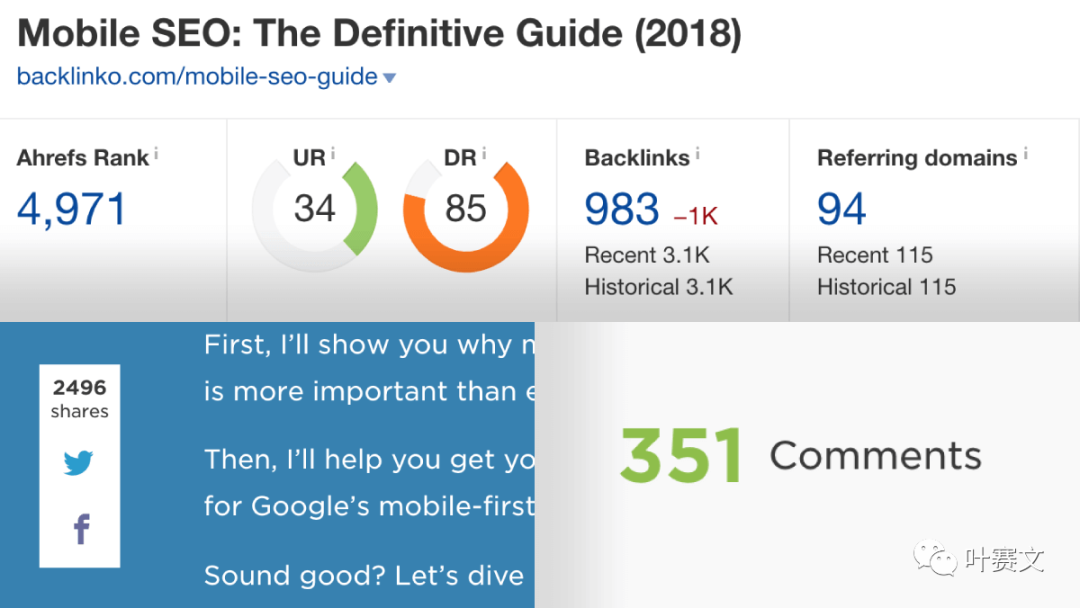
Also, this post ranks in the top three in my target keyword mobile SEO:

I got the idea to write this article from BuzzSumo.
This is how it is done
A few months ago, I searched BuzzSumo for "SEO":

In this way, I can quickly find in the SEO field by a lot of people to share, there are a lot of external chain content.
I also used the filtering function to filter the pick-up:

(I'll explain it in more detail later.) )
I noticed that four of the first 20 articles were about "mobile SEO".
As I dig deeper, I realize that at least three of the top 20 posts involve the "Mobile SEO" topic.

So:
In the SEO field, 7 out of 20 most popular posts (about 35%) are about mobile SEO.
That's when I realized that I'd better make a breakthrough in mobile SEO.
At the same time, I'm aware of one thing:
None of the seven posts taught people how to optimize their sites for mobile devices.
Therefore, I feel that there are a lot of practical techniques to fill this content gap:

Because my content is based on a proven topic, and the content is unique and practical. So, in the end, this article got a good performance.
Steal your competitors' best content ideas
Did you know that you can search for a domain name in BuzzSumo?
It's able. And it's very cool.
After you enter your domain name, you can see the best content on this site.
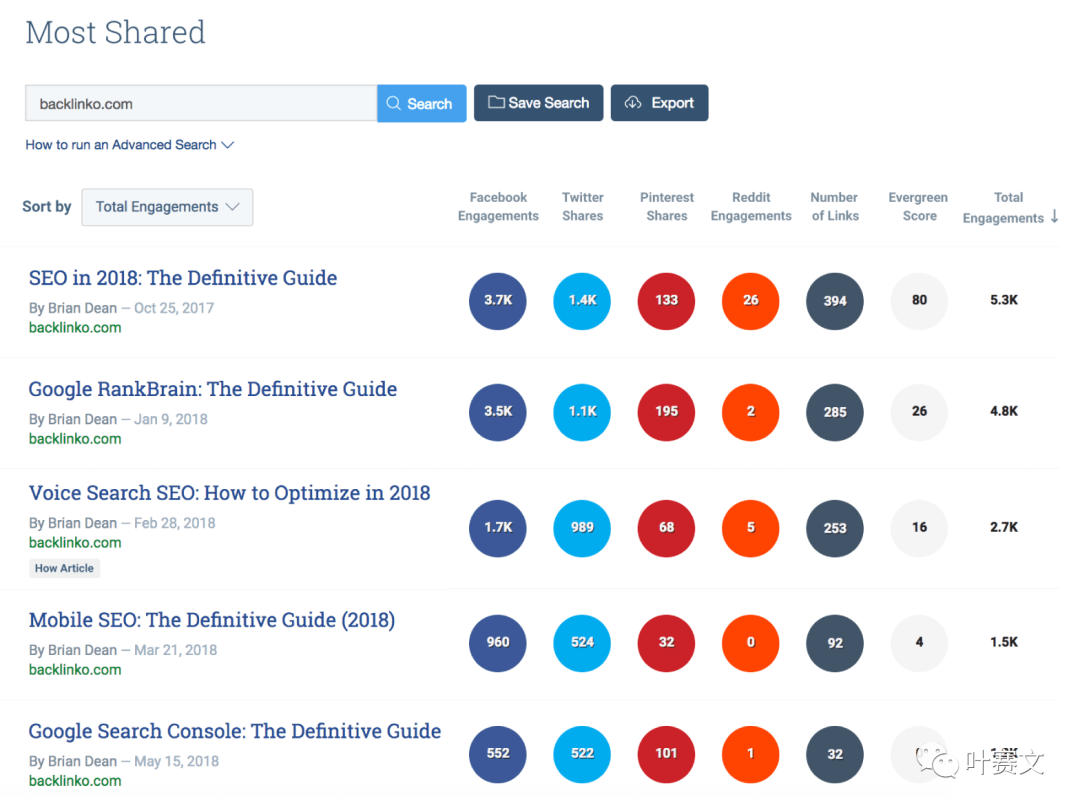
This feature helped me create my best posts:
SEO 2018: Authoritative Guide.

This article has gained a lot of sharing and chaining.

It's in the top 10 of the pages that bring me the most natural traffic each month.

I'll show you the steps I took to create this article.
First, in BuzzSumo's search box, type the URL: moz.com

I immediately found something surprising:
The number one post on Moz's blog (out of more than 400 posts) is: How to do SEO in 2018.

To further study:
On Moz's website, the top 10 traffic articles are all about SEO

I've never considered writing a post like "SEO in 2018."
(Why?) Because most of these posts are of little value. )
But seeing that the theme worked well on Moz, I decided to give it a try.
My article, unlike others, has only some predictive information. It contains a number of actionable steps.

As mentioned earlier, this article has an overwhelming advantage.
There's a lot of traffic in the first week of release:
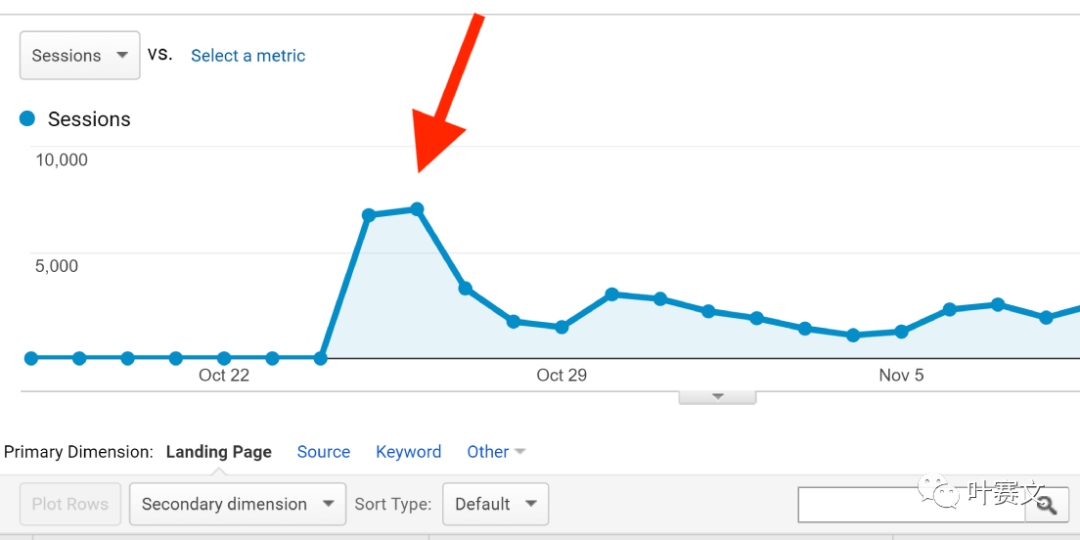
Although this article has been published for six months, it still gets steady traffic from Google, social media and blogs.

Use Question Analyzer to discover unexepped long-tailed keywords
This is one of my favorite buzzSumo new features.
Why do you say that?
First, you can use The Problem Analyzer to see the questions people are asking on Reddit, Quora, and forums.

In this way, you can see some pressing issues in the industry.
Well, that's cool!
But that's not the main reason I use problem analyzers.
I mainly use itFind long tail keywords.
Why is that?
When someone asks a question on Reddit, it usually means they googled it, but didn't get the results they wanted.
To put it another way:
A lot of people are looking for this problem... But the results are rotten!
So if you can create a content to answer that question, you'll get a lot of traffic.
Take a look at this real case:
Earlier this year, I decided to update this post:

I've added new screenshots, updated old content, and removed outdated content:

I realized that the title would bring a lot of traffic.
As you can see, the old labels are:

As you might guess, the target keyword for my page is :YouTube SEO.
My post ranked first in SERP for this keyword:

I also realized that if you include long-tailed keywords in your title, you'll get more Google traffic.
The questions are:
What kind of long tail words should I choose?
Back in the day, I used Google Keyword Planner and typed "YouTube SEO" into it.

However, only a few similar keyword variants can be obtained:

(You can see that most of these variants have very low searches)
I used BuzzSumo and typed "YouTube SEO" into the problem analyzer:

I got a list of people's questions about this topic:

A particular question immediately caught people's attention: "How do you rank Youtube videos?" (How to rank youtube videos)":
My post answers this question, but it's not optimized for this keyword.
So, I added a simplified version of this long tail word to the title:

It quickly became the first of the long tail keywords:

This increased the natural traffic of the page by 23.49%.

Cool!
Crack Facebook's news feed with a Facebook analyzer
No doubt:
Getting your Facebook posts on your followers' news feeds is harder than ever.
But there's an easy way to solve this problem: BuzzSumo's Facebook analyzer.
This tool shows you what's doing well on Facebook right now:

This makes it easy to copy high-traffic posts.
For example:
Let's say you run a Paleo diet blog.
You will search for "Paleo":

You can see the most interactive posts about natural diets in a time period:

Important: Set a date range for "Last 6 Months" or "Last January."

By default, BuzzSumo shows you what's been in the last 24 hours, which is a very short time range. Therefore, it's important to set these filters so that you can see what's worked well over the past few months.
If you would like to delve into it, please click on "Analysis trends":

This will show you what the most successful Facebook posts have in common (format, length, release time, etc.).
For example, in the field of natural diet, video formats outsrate other post formats:

You can also use this feature to analyze specific Facebook pages. That way, you can see directly how competitors do it. Then we can learn from and imitate the competitors' methods.

Get more results from your content with Content Analytics
You've found a topic that's proven to be worth writing on.
Very good!
Here's the problem again:What should I actually write?
There are no tools for you to write a post.
(AI is good, but at the moment, it's not that good!) )
However, BuzzSumo's Content Analytics can help you write popular posts.
I use a real-life case to illustrate:
A while ago I sat down to write my mobile SEO guide.

I already know how to organize and write posts.
But I still use the Content Analytics feature to make sure my content is popular.
First, I'll look at which content type is best for the topic.
To be sure, articles of the "How-to" type work best:
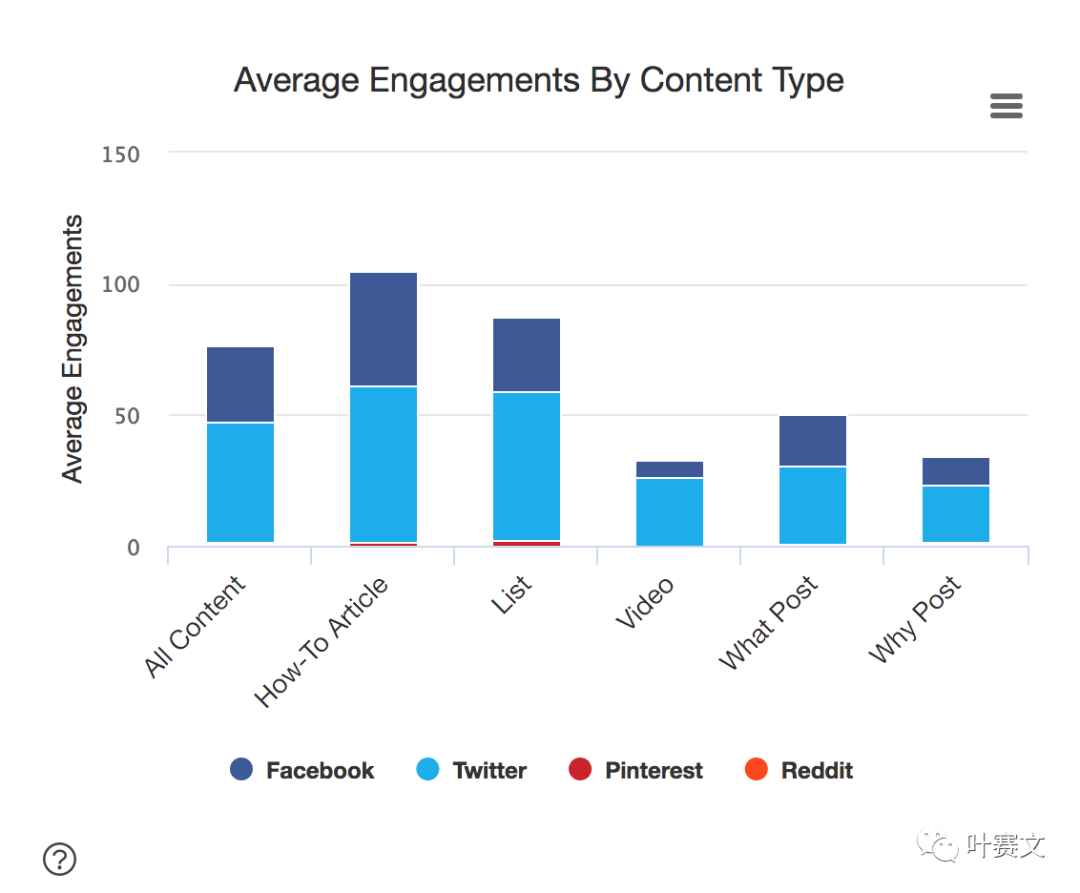
Best of all: I'm planning to write a "how to" getting started guide
I've also noticed that the topic of mobile SEO is more popular (in terms of social sharing):
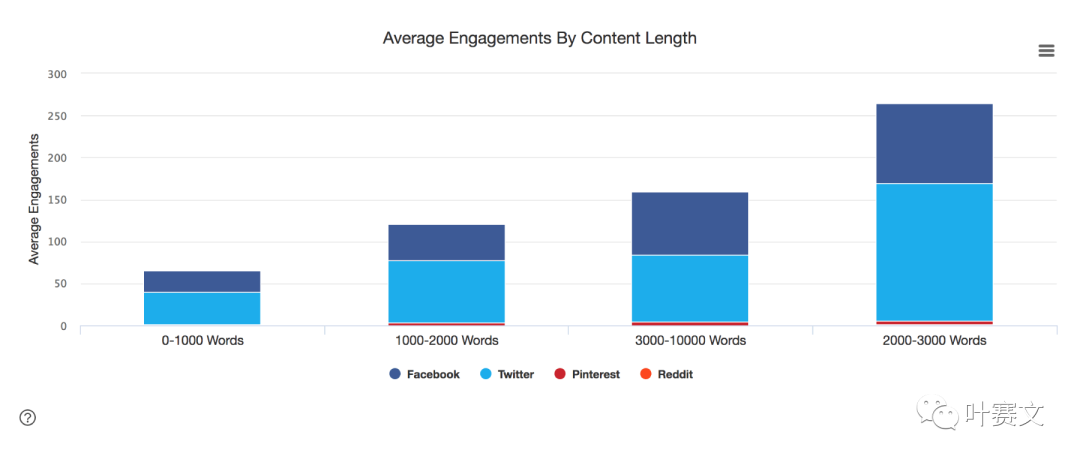
I am inclined to publish long essays. But it's nice to be confirmed that the long content fits the theme I'm going to write about.
So:
The subject matter and content type of the article have been validated, and this can give you a 90% lead over your competitors.
However, as you may know, clicking the Publish button is only the first step.
To keep your content on Google's home page, you also need to actively promote it.
This is the problem to be solved in Chapter 2:
Chapter 2: Looking for red people
You already know that by sharing your content once, you can make your posts hot.
But how do you find them?
BuzzSumo has some great features to help you find net reds and bulls in your industry.
In this chapter, I'll show you how to use them.
Find red people by keyword
So far, this is the easiest way to find red people in a particular market segment.
Type a keyword to get a list of topics:

Attention: BuzzSumo searches only for Twitter profiles. Therefore, if the red person does not mention the search term in his resume, it will not appear in the search results.
For example, if you search for Link Build, my Twitter profile won't appear because I don't have the term in my Twitter profile:

That said, keyword search is still a good way to start building a list of red people.
The next step should be to:
Discover Red People using Search Content Shared
At the end of the day, the goal of content promotion is to get someone to share your content with their fans.
This sharing can take the form of a Facebook post or a link.
Either way, you need to show your content to people who might share it.
What's the best way?
Use Search Content Shared
This feature can be displayed recentlyPeople who share your topic contentinstead of searching through a Twitter resume.
(This means they're most likely to share your content)
For example, I'm going to post an SEO case study on my blog:

I know this article will catch fire.
If I can show it to the people who need it.
That's what I do:
First, see who's sharing the content. This way, I can get a list of people who recently shared SEO and content marketing case studies.

I filtered the results to find people who might share my posts.
(Especially those who have a lot of Twitter followers... They also write articles about SEO and content marketing)
This kind of person is easy to find a bunch.

Then I emailed them.

(As you can see, I email everyone with a personalized template)
When someone said they were interested in my post, I sent them a link:

Because I'm not in a hurry, most people are happy to read my article...
... and shared it:

Find top authors in your industry
You can also use BuzzSumo to find the best and worst authors in your industry.

What can you do with this information?
First, you can get a list of head blogs and reporters on your topic.

(This will help you build a red list)
But the biggest benefit of this feature is that you can see what the movie star wrote:
Theme, angle, format.
Why is this important?
If you want people to share your content, they actually need to like your content.
You might say "I know."
But it's true.
In fact, I often get emails like this:

I basically don't share such articles.
Because I've never written anything about nonprofit marketing, and I haven't shared anything about it.
On the other hand, someone recently sent me an article about e-mail marketing:

Yes, this is a promotional email. However, if the author Benjamin wrote the theme, which I didn't care about, I would delete it directly.
Fortunately, what he's talking about (the actionable user-sucking method) is something I've studied.
That's why I share it.

Monitoring function
In this chapter, I'll show you how to get the most out of BuzzSumo's Monitoring feature.
I think that's the most powerful feature of it.
Seriously.
In this chapter, you'll learn how to use monitoring to build strategic relationships, get more backlinks, and understand what people say about you online.
Turn unlinked mentions into backlinks
Usually, when someone mentions you in a blog post, they link to you.
But sometimes someone mentions your brand... There is no link to your website.
Here's an example:
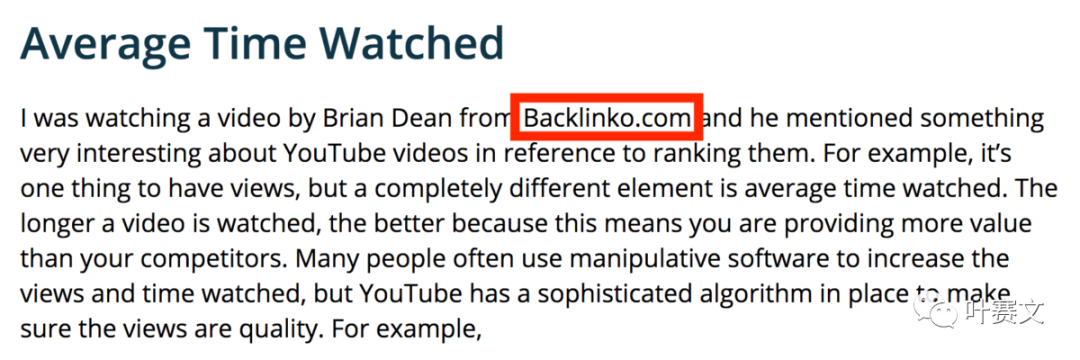
It turns out that you can easily turn unlinked mentions into backlinks with simple e-mail messages:

The questions are:
How do you find these unlinked mentions?
Monitor with BuzzSumo.
Just add a new Brand Mention to your brand:

You'll see forums, blogs and news sites that mention your brand.

In the results, if there is a small link icon that indicates that the article is actually linked to your site:

The results show that "no link" refers to your brand... Doesn't link to you:

It's easy!
Find out who links to your competitors
People who link to your competitors are also likely to link to you.
Right now:
You can use tools such as Ahrefs to find backlinks to competitors.
(It's absolutely valid)
But there is a problem with this approach:
It's hard to find someone who's recently linked to your competitor.
You need to filter thousands of links... Many of these links are more than 5 years old.
Monitoring.
With monitoring, you can see which sites are linked to your competitors:

It even shows you how many times the content has been shared... and the domain name authority of the site:

It's very simple.
Find conversations about your brand
In my opinion, BuzzSumo has one of the best brand monitoring tools on the market.
I have tested all the products on the market.
Since I started using buzzSumo tracking references in 2014...

... I've noticed that it finds more brand mentions than any other tool.
Attention: I monitor mentions purely on news sites, blogs, question-and-answer sites such as Quora, and online communities. BuzzSumo doesn't track mentions on social media platforms like Facebook.
So, what's the use of this feature?
Whether you like it or not,People will talk about you online.
If you look closely at these conversations, you can see people's preferences for your brand.
If it makes sense, you can engage in these conversations:

Fortunately for me, most of the talk about me and Backlinko has been positive:
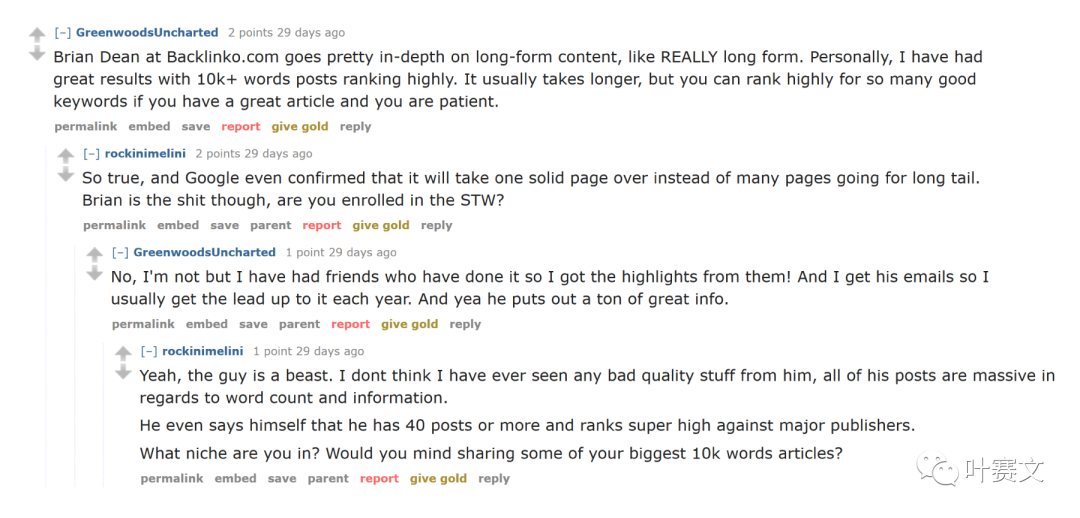
Most are 🙂

It's a good thing for me to be talked about!
See who's linking to you
You can ask BuzzSumo to send you an email alert when you receive a new backlink.

Or check all new links once a day:

(I check it more than 10 times a day??? )
What's the use of this information?
Connect with people who link to you
This is especially powerful for authors writing for multiple websites.
When you send them a quick message "Thank you! , they are more likely to link to you in a future article.
For example, I noticed that I got a link from Crazy Egg a few days ago:

When I clicked on the author's name in BuzzSumo, I noticed that he had written for many different marketing and online business blogs:

I sent him a short message thanking him for mentioning Backlinko in his post.

What needs to be clear is:
I'm not manipulating or masking.
Instead, I'm building strategic relationships with people who write in my market segment.
Chapter 4: Cool BuzzSumo features
In this chapter, you'll learn some of my favorite BuzzSumo features.
You'll learn how to use BuzzSumo to create viral content, create better infographics, and take your content promotion to the next level.
Monitor when and where keywords are used
In Chapter 3, I showed you how to track conversations about your brand online using BuzzSumo Monitoring.
What you may not know, however, is that you can also use BuzzSumo to track mentions of keywords.
For example, I've been tracking the keyword Skyscraper Technology since 2015.

This report lets me know if people are still talking about skyscraper technology.
(Fortunately, people are still talking about it).
You can also use this feature to present content to people who might share it.
I'll use an example to show how to practice...
A few months ago, I released voice search SEO research.

This article does a good job of linking...

... But I know it's possible to get more links.
Therefore, I recently set a reminder for the keyword Voice Search.
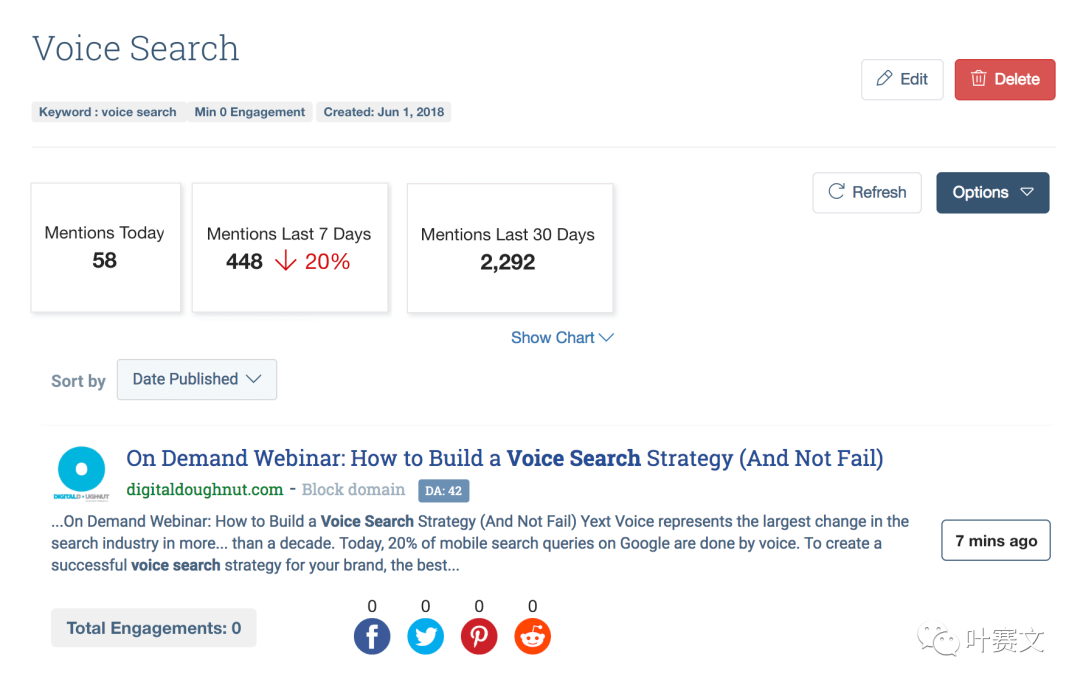
In this way, I can easily find people who write about voice searches and present my research to them.
Create better infographics
No doubt:
Creating an infographic that will stand out in 2020 is very difficult.
Fortunately, you can easily increase the chances of an infographic succeeding.
Here's how to do it:
First, search for the target keywords:

Select More Filters and select only the infographic
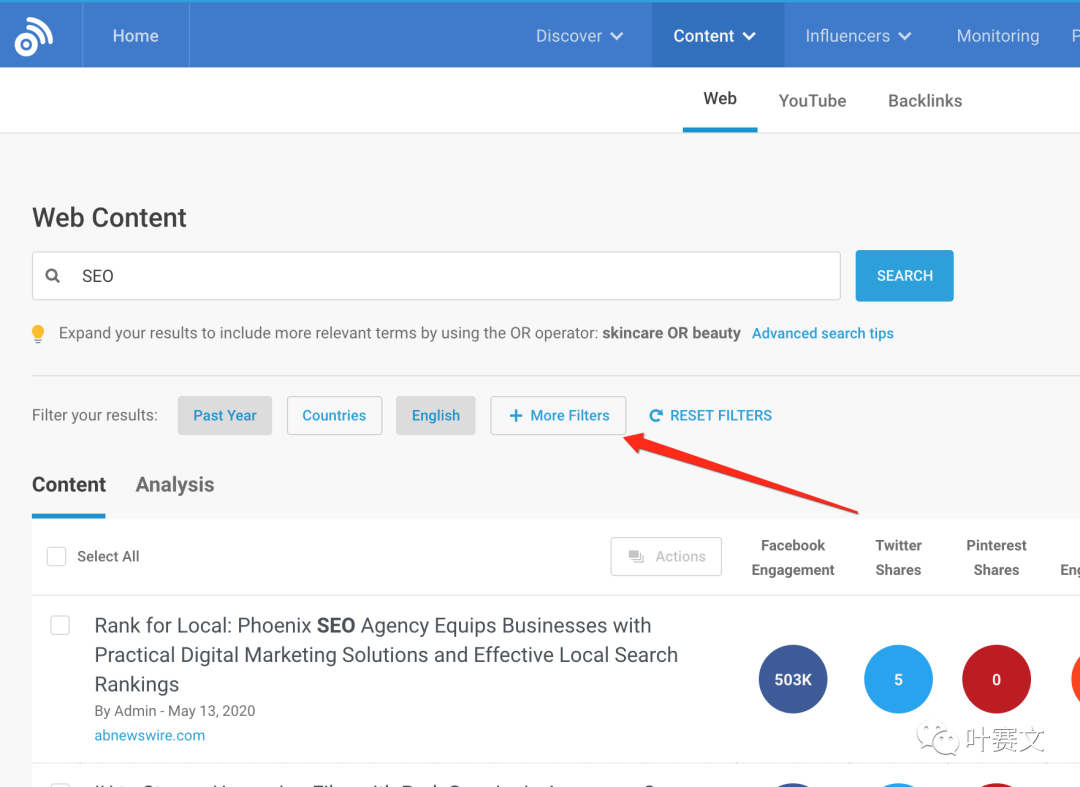

You can see a few infographics that people actually share:

In B2B? Use this filter
If you're in B2B, you'll soon notice some BuzzSumo search results filled with irrelevant content.
For example, "Seo" has proven to be a common surname used by Vietnamese.
So when I searched for "SEO" in BuzzSumo, the vast majority of the results came from Vietnamese news sites:

But when I selected Only B2B Publishers...

... I got a clean list of results:

That's nice!
Get a higher ROI with Evergreen Score
It's no secret that I'm a fan of evergreen content.
(Actually, I'll only publish articles that bring ongoing content.)
When you do a regular BuzzSumo search, the results are sorted by number of shares:
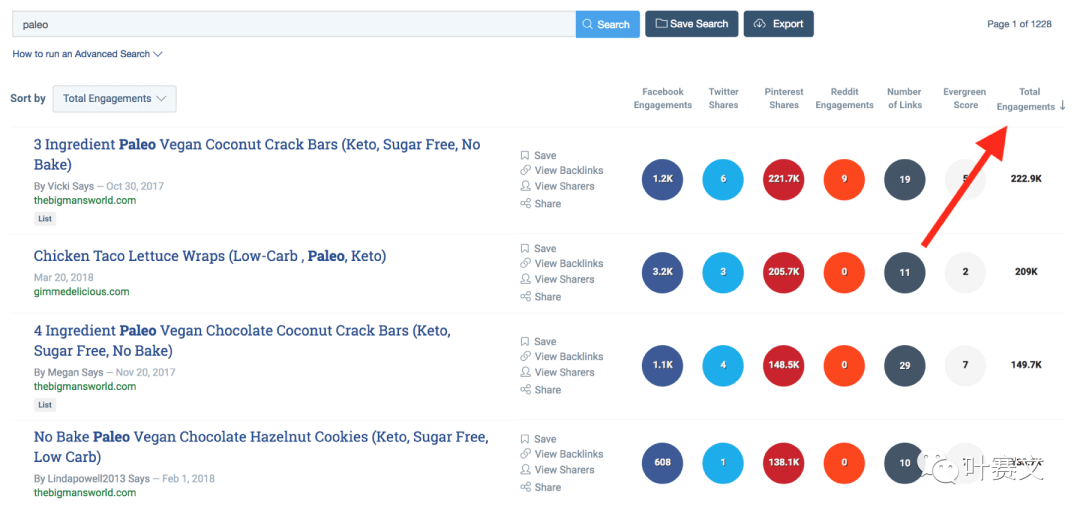
And you don't know if these shares came from the day after the release, or a few months later.
Let's look at evergreen scores:
Evergreen Score refers to content that can be shared and backlinked continuously after an article is originally published.
For example:
If you routinely search for BuzzSumo for "SEO," my content won't make the top 20:

As you can see, the results are dominated by big brands such as HubSpot and Marketing Land:

However, when you sort the results by Evergreen Score, notice what happens:

My article "SEO in 2018" has a high evergreen score because it still brings value after publication.
(This means that people continue to share and link to it)
So if you want to create content about SEO, my guide will be a good model.
Chapter 5: The latest case study
In this chapter, you'll see four new BuzzSumo case studies.
Specifically, you'll know exactly how people use BuzzSumo to create viral content, create backlinks, improve their Google rankings, and more.
Let's get started:
Case Study 1: How James stands out in media such as Mashable, Cosmopolitan, MTV, The Daily Mail, and more
James Brockbank recently used BuzzSumo to get links and mentions on Esquire, Glamour, MTV, Bustle and other authoritative websites (mentions):

Good results:
The links help James's customers rank on Google UK's front page in terms of "women's casual wear tracksuits in the UK," "slogan jumpers" and many other items, just in time for Christmas.

Overall, this campaign increased searches by 87.9 per cent:
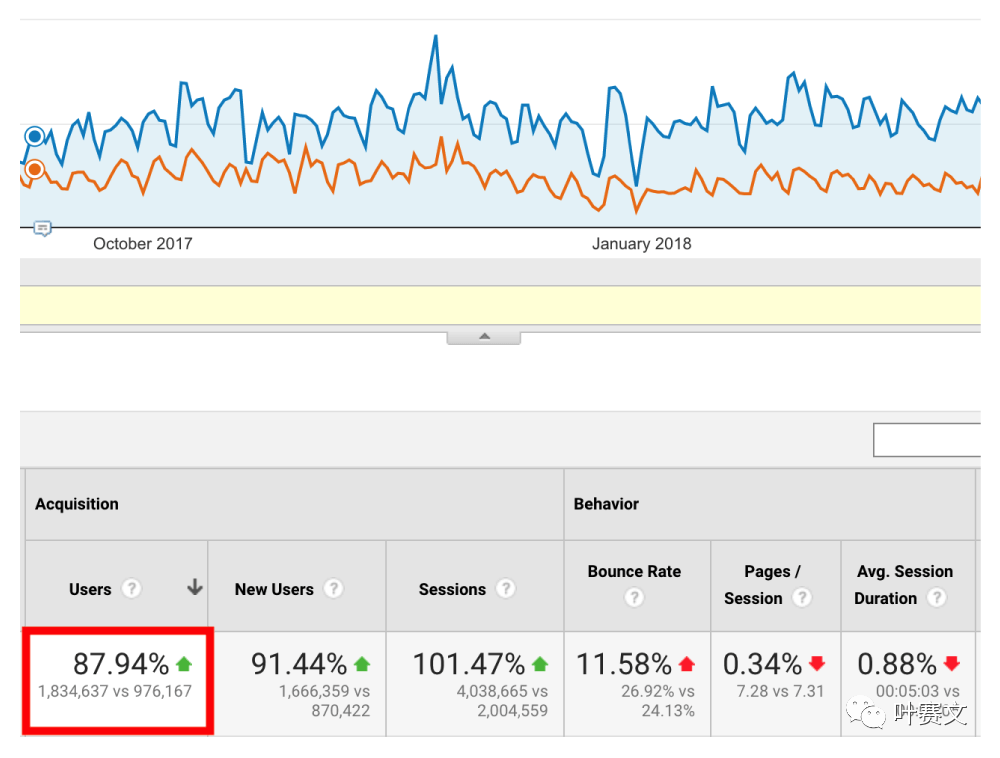
Here's the full story:
James' client is Missy Empire, a fashion e-commerce site.

According to James:
"Our customers have been working on 'style guides' and other blog content, but are struggling to get links."
So he decided to try something new:
Create something you want to share with fashion blogs and news sites
So he used BuzzSumo's domain search to discover fashionable content that was heavily shared.

James can sum up what he finds in one word:
Kardashian
James also stumbled across Forbes' "Superstar Rich List," which lists the income of each Kardashian family member.

So James created a simple calculator that lets you compare your income to Kardashians.

The media love this tool.
In fact, to date, the tool has received links from more than 130 blogs and news sites:

Case Study 2: How Matteo got 190 social shares (and 64 new backlinks) for a new blog
Last year, Matteo Gasparello ran into problems.
He has just started a brand new digital marketing blog.

Matteo knows that to stand out from the crowd, he needs to post some great content.
The questions are:
What should he post? List posts? Tutorial? Or a case study?
So he decided to use BuzzSumo.
He then searched for keywords such as "video marketing," "Facebook video ads," and "video ads":

Matteo quickly noticed that four posts were doing very well:

So he writes his favorites from these four articles into his new tutorial: Online Video Ads: Everything You Need to Know in 2018.

Given that Matteo's blog is brand new, he knows he can't publish articles after doing nothing but begging.
So he used BuzzSumo to find people who had shared video ad content in the past:

As Matteo says:
"Now you just need to browse the results and connect with people who are really interested in video ads."
He then contacts these people through personalized (non-false) emails:

Matteo's promotional emails were both targeted and polite, so he got a lot of these responses...

And this:

When Matteo started sending its own quality tutorials to interested people, the number of shares and links soared:

So far, Matteo's post has done well:
64 backlinks
190 shares
2200 views
120 new email subscribers
Case Study 3: How Neil Sheth ranks customers on Google's first page
Neil Sheth runs a digital marketing agency called Only Way Online in London.
A few months ago, Neil got into trouble:
His client runs a helicopter leasing business.

Like most SEO customers, Neil's customers want to rank the keywords they search for.
The questions are:
No one wants to read the following: "5 Tips for Renting a Helicopter" or "Renting a Helicopter: The Ultimate Guide."
This means that he must have new ideas.
Neil knows that many clients rent helicopters for weddings.
So he decided to create content about planning a wedding.
Next, Neil uses BuzzSumo to find out which type of content format works best:

He noticed something:
Most list posts (such as "5 Tips for Planning a Wedding") don't get much to share or link to...
... But the comprehensive guide does a good job.
Here's an example:

So Neil set out to create the best wedding planning guide on earth.
Finally, this article was written as the Ultimate Wedding Planning Guide.

Because this guide provides a lot of practical value, I received some backlinks to the lichi-related wedding blog:

These links have led to a surge in natural traffic across the site:

These links also help Neil's customers get a home page ranking for a keyword that brings in several new prospects each month: "helicopter proposal London":

Case Study 4: How Andrew Holland received 261,457 views for a viral passage
Andrew Holland set himself a goal a while ago:
Create content for his self-defense blog and let it explode.
It's easier said than done.
Instead of relying on pure luck, Andrew uses BuzzSumo to see what types of content (and titles) are shared by many in the martial arts world.

Andrew tends to do well when he sees the "best" list.
So Andrew decided to write a post about the best self-defense martial arts list.
Final result: Top 10 Best Self-Defense Martial Arts.

As you'd expect, Andrew's post was controversial.
This means:
People who like Andrew's content - they share posts.
People who hate Andrew's content - they share it too!
These shares have led to a surge in traffic:

(261,457 visits to date)

Then Andrew did something interesting...
Because most of his sharing comes from Facebook, Andrew turned his post into a Facebook video.

The video has been viewed 174,000 times and shared more than 1,200 times.
Chapter 6 Advanced Tips and Strategies
What's the basics? It's over
A case study? It's over
Now we'll dive into BuzzSumo's advanced tips and strategies, which you can use to hire freelance writers, find great keyword tips, and more.
Let's go!
2020-10-08 06:46:33
Find high-quality freelancers
It's easy to find freelancers.
But finding a high-quality freelancer is another matter.
Fortunately, you can use BuzzSumo to find out where they are written.
Method:
First, search for your topic in BuzzSumo:

Then, keep an eye out for those who have gained a lot of sharing in previous works.
Right now:
Most of these writes are industry bulls... Not a freelancer:

However, if you delve into it, you'll find freelancers. They know how to write good posts in the lichi market.

Tips. : Click the name of the written person in the search results... and you can see everything they post:

Use Search by Subreddit to create the target content
Does your target audience like a particular Subreddit?
If so, BuzzSumo can show you the questions these people are asking.
(and the topics they're most interested in)
Let's have a real case:
My content is designed to help professional marketers get higher rankings and more traffic.
There's an r/SEO subreddit section...

... There are new people everywhere.
However, my target audience uses r/bigSEO more.
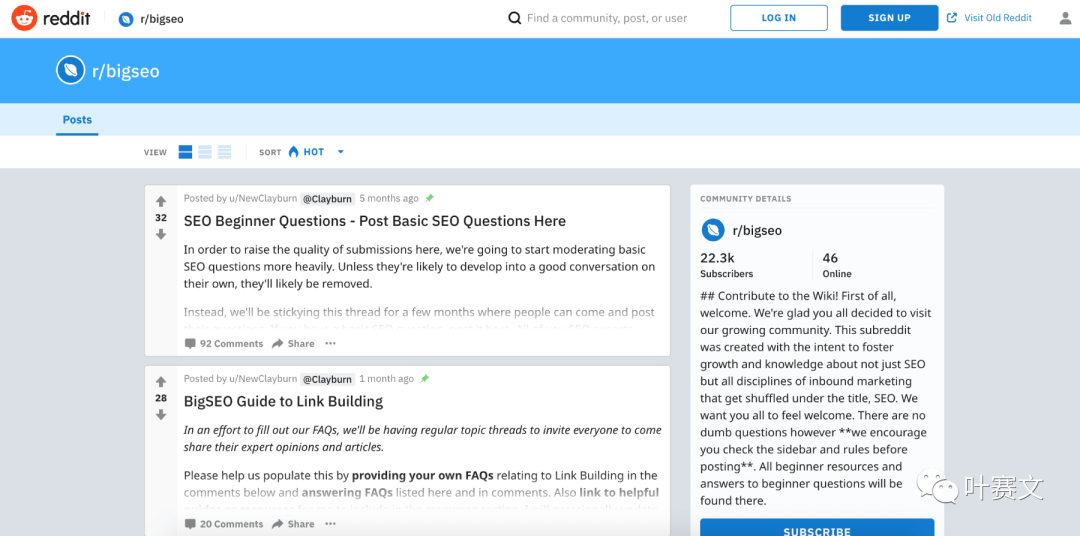
With BuzzSumo, I can easily see the topics that subreddit members are most interested in.
Method:

BuzzSumo gives me a list of the topics that subreddit members most discuss:

Use BuzzSumo to find keyword tips
It doesn't make it any easier:
Just enter keywords in the BuzzSumo search...
... Take a look at their advice to you:

Even cooler, you can search for "keywords A", "keyword B" and so on for more keyword tips:
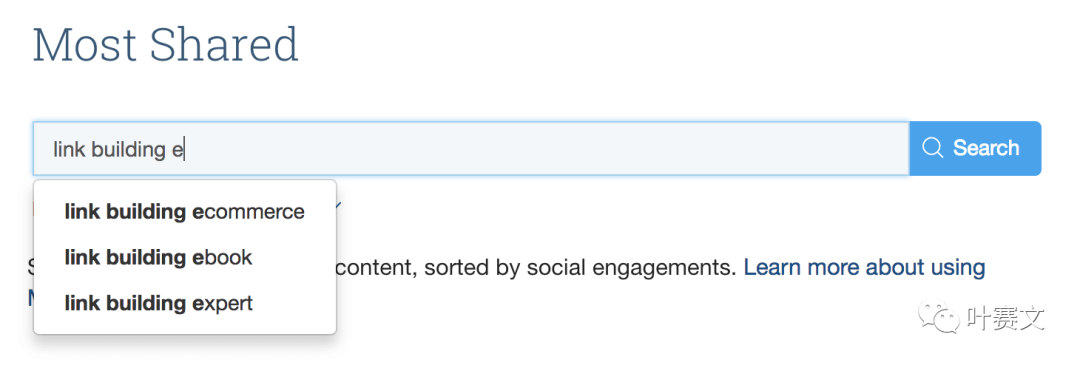
Track brand impact (and backlinks)
Are more people talking about your brand this month?
This is not an easy question to answer.
However, you can use BuzzSumo to track mentions and links.
Set up mention monitoring, and you can see changes in mentions and links.

If you find that more people are talking about you (on the positive side), your marketing is working.
If not, maybe it's time to change.
Look for high-quality interview opportunities
Interviews are one of my favorite ways to get targeted traffic (and links).
The only problem is:
It's hard to find high-quality interviews.
Fortunately, BuzzSumo makes the process easy.
Here's how:
First, find someone in your lily market who is easy to interview.
(In this example, I'll use my friend Noah Kagan)
Then, enter his or her name in the BuzzSumo search:

Why?
Well, unless someone is really popular, they'll only appear in Buzz Sumo's results in an interview.
For example:
When I searched for "Noah Kagan" in BuzzSumo, 18 of the 20 results were from his interview.

Cool.
Now it's your turn
So these are my best tips, strategies, and tips to get the most out of BuzzSumo.
Now, I'd like to hear from you:
Which strategy do you want to try in this guide first?
Do you want to use BuzzSumo to find a player? Or maybe you want to start tracking brand mentions.
Either way, leave a message below right now and let me know.
---
By Brian Dean
Original post at https://backlinko.com/buzzsumo-guide
Translation: Ye Saiwen
Welcome to WeChat Public Number: Ye Saiwen for the latest articles


Send to the author